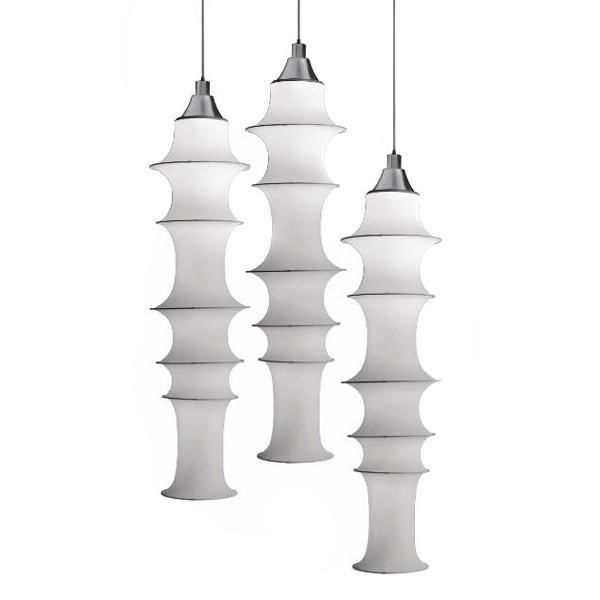I wasn't really all that familiar with the work of Bruno Munari until by chance I found myself witnessing a Bruno Munari installation (of sorts) at the 21st Century Museum of Contemporary Art in Kanasawa, Japan. Munari was no longer alive (this was 2009 and he died in 1998) so I presume this was a recreation of a past installation or just a wonderful idea by a Munari enthusiast within the gallery staff. Either way it alerted me to the beauty and breadth of his work beyond the classics I already knew about - his well-known and rather fabulous 'Falkland' lights and his 'Canarie' desk accessories - both available from Danese Milano. The installation involved large scale versions of the same printed acetates found in his children's creativity set 'Plus Minus' published by Corraini. Hung in an area near the museum's bookstore, the installation of layered sheets was pumped with stage smoke to create a surreal foggy atmosphere (and I suppose to enhance the 3-D effect created by the layered illustrations). The bizarre scene of smoke billowing around young children as they ran through the acetate sheets was wonderfully un-PC and certainly in keeping with the museum's style (you can drive around the exhibits in pedal cars and the outdoor sculptures are like tubas growing in a field). Anyway, I was sufficiently hooked from this encounter to have forced his children's books on my unsuspecting nieces and nephews (they will thank me one day) and felt inspired to write this post as soon as Patricia Urquiola mentioned that the inspiration for her intriguing 'Crossing' table for Glas Italia (2012) was none other than Mr Munari.
Munari may not be as well known as his contemporaries, like Achille Castiglioni or Enzo Mari in design, or Lucio Fontana in art, but he was an important influence right across art, design and illustration and this influence continues today. Born in MIlan in 1907, Munari began his artistic career as a Futurist painter in the 1920s but over the years worked as an illustrator, designer, inventor, and photographer. All of his work was inventive with an unabashed sense of fun. His early sculptural designs were a play on light and shadows and in many ways were a precursor to the kinetic work of artists like Alexander Calder.
Munari wanted ‘to free abstract forms from the stasis of paintings and suspend them in the air’. This concept was experimented with as early as 1930 and was not only revolutionary in the art world but influenced a host of lighting designers to pursue a more ethereal approach that focused less on light as an object and more on it's overall emotional effect. To Munari his free-floating forms had a liberating poetic function that offered respite from the general obsession with industrialisation. He described them as ‘objects to look at the way one looks at a drifting cloud having spent seven hours inside a factory full of useful machines’.
"You must always have something to look forward to, because, if you have something in the pipeline, you stay young". Bruno Munari
In the 1950's Munari created a body of work called Negative-Positive. These paintings explored the manipulation of colour within strict shape guidelines and played with each element's role as part of the entire composition. Depending on the colour and shape chosen, areas could be considered as part of the foreground or background and the result was highly dependant on the viewers personal response. In some works the wall on which the painting hung could became part of the composition too, creating a heightened sense of 3-D. While these works are a form of optical art (created well before the term existed), these paintings have a compositional beauty that goes beyond just tricking the eye. Munari revisited this series over the years - right through to the late 1980's.
His work in graphics was also an exciting part of his wide ranging artistic expression. He was co-director of the magazine Ufficio Moderno and graphic director of Tempo in the mid to late 30's and published books like Palette of Typographical Possibilities. The Penguin Modern Classics book Design as Art, originally released in 1971, remains an important reference on visual, graphic and industrial design and the role it plays in the objects we use and see on a daily basis.
Munari's work in design was equally thought provoking and while only a small number of his designs are still in production those that are give a good sense of his ability to control form. HIs 'Falkland' pendant lights designed in 1964 are long drops of stretch fabric that moves in an out around different sized hoops creating a highly sculptural shape. Totemic enough to draw attention they are also soft enough to avoid being overwhelming. An earlier lighting design from 1959 - also a flatpack - called 'Esagonale' (hexagon) is highly geometric by comparison being made up of seven concentric hexagons that drop into place when lifted from the box. Both designs are available through Danese Milano.
All through his life Munari created children's books that either involved his charming illustration style or his brilliant way of exploring visual elements. Initially many of these books were published by The World Publishing Company with titles including 'The Elephants Wish' and 'Bruno Munari's Zoo'. In more recent times the Italian publisher Corraini, who publish unusual books loosely based on art and design, have released 'Romilda the Frog' and the 'Plus and Minus' visual creativity set mentioned previously. Chronicle Books also now publish some of his early titles.
"When the artist observes nature... it is as if nature communicated, through the sensitivity of the artist at that moment, one of its secrets". Bruno Munari
For an in depth look at the life and work of Bruno Munari check out www.munart.org a website dedicated to all things Munari.





















